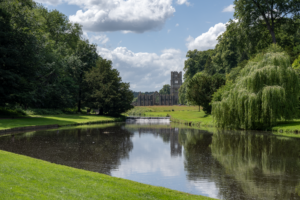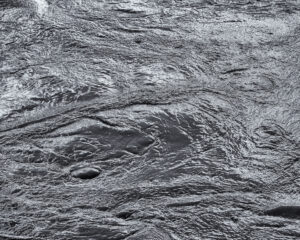Fountains and rain: Improved nowcasting techniques to help adapt heritage landscapes to changing rainfall patterns
Highlights:
- Technology-led research to develop new nowcasting equipment of river flow (velocity and water level)
- Field study site part of new instrumented catchment, the Skell Valley Project, tied to existing infrastructure.
- High potential for impact by providing rapid information to support responders and stakeholders during flood events, and to inform adaptation strategies.
- “Partnership Project” (a CASE project) with the National Trust

Overview
Water is an integral part of many of our most culturally important heritage landscapes. The increasing frequency and magnitude of flooding will damage landscape features and hinder conservation of our historic landscapes. Traditional flood forecasts are not sufficiently high resolution to provide accurate predictions of water height and flow regime. Additionally, real-time data collection on river height and velocity during a flood event is dangerous.
How can novel technological innovation better inform and prioritize decision-making about heritage landscapes? This technique innovation studentship aims to develop, test, and validate a novel large-scale particle imaging velocimetry (LSPIV) system to collect real-time data on surface water velocity and water level during flood events. This will provide user-centric surface water nowcast information to better support risk management authorities in their responses to river and surface water flooding at cultural sites that are susceptible to flooding and damage.
The studentship will examine the UNESCO World Heritage Site of Studley Royal, which incorporates the ruins of Fountains Abbey, although the outputs will be relevant to heritage sites with a water context worldwide. Since the 12th century foundation of the abbey, hydrological changes in surrounding land management and climate have impacted the landscape. Recently, change has accelerated, and the consequences for the site’s structures and environmental future have become more acute. Ongoing research at the site has established a new instrumented catchment to investigate the effect of natural flood management interventions, as part of the Skell Valley Project. This means that the deployment of the LSPIV technique can be tied to, and validated against, an existing data infrastructure. This will help address pertinent questions around planning for the prevention, adaptation, and/or resilience for the site.

Aims and Objectives
This PhD studentship aims to develop an improved technique for the quantification of flood events and regular hydrometric monitoring. The PhD student will have opportunities to develop all aspects of this improved methodology and lead a series of fieldwork investigations to test the new measurement system including:
- Undertaking a series of laboratory experiments to develop a new measurement technology.
- Developing an instrumented field site in conjunction with the National Trust.
- Deploying the new instrumentation in field trials at a range of different river stages, using the instrumented Skell Valley catchment, including Fountains Abbey and Studley Royal.
Potential for high impact outputs
The PhD integrates recent advances in both imaging and LIDAR technology to make a step-change advance in hydrometric measurements. For the first time, it will be possible to make areally extensive measurements of both flow velocity and water stage. It is expected that this research will generate high quality (4 star) research papers that have significant impact within the field. There is the potential for rapid adoption of this new technology by the hydrometric community through improved accuracy of discharge measurements to calculate incremental discharges downstream.
Training
This PhD will commence before the end of 2024 and run for 3.5 years. During this period, the student will be eligible for all the postgraduate training typically provided to students attending the University as part of the PANORAMA DTP. The PhD will provide an excellent training in state-of-the-art experimental and field based quantitative hydrodynamics, a key skill set for both future academic and industrial based employment. Research skills and impact will be supported by a supervisory team with leading expertise in experimental fluid dynamics, qualitative fieldwork, environmental management and modelling of flood events. The PhD will benefit from access and training to use state-of-the-art equipment and facilities at the University of Leeds.
